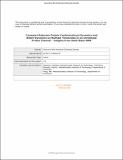Transport-Relevant Protein Conformational Dynamics and Water Dynamics on Multiple Time Scales in an Archetypal Proton Channel: Insights from Solid-State NMR
Author(s)
Mandala, Venkata Shiva; Gelenter, Martin David; Hong, Mei
DownloadMandala W41F R1.pdf (2.265Mb)
PUBLISHER_POLICY
Publisher Policy
Article is made available in accordance with the publisher's policy and may be subject to US copyright law. Please refer to the publisher's site for terms of use.
Terms of use
Metadata
Show full item recordAbstract
The influenza M2 protein forms a tetrameric proton channel that conducts protons from the acidic endosome into the virion by shuttling protons between water and a transmembrane histidine. Previous NMR studies have shown that this histidine protonates and deprotonates on the microsecond time scale. However, M2’s proton conduction rate is 10–1000 s⁻¹, more than 2 orders of magnitude slower than the histidine-water proton-exchange rate. M2 is also known to be conformationally plastic. To address the disparity between the functional time scale and the time scales of protein conformational dynamics and water dynamics, we have now investigated a W41F mutant of the M2 transmembrane domain using solid-state NMR. ¹³C chemical shifts of the membrane-bound peptide indicate the presence of two distinct tetramer conformations, whose concentrations depend exclusively on pH and hence the charge-state distribution of the tetramers. High-temperature 2D correlation spectra indicate that these two conformations interconvert at a rate of ∼400 s⁻¹ when the +2 and +3 charge states dominate, which gives the first experimental evidence of protein conformational motion on the transport time scale. Protein ¹³C-detected water ¹H T₂ relaxation measurements show that channel water relaxes an order of magnitude faster than bulk water and membrane-associated water, indicating that channel water undergoes nanosecond motion in a pH-independent fashion. These results connect motions on three time scales to explain M2’s proton-conduction mechanism: picosecond-to-nanosecond motions of water molecules facilitate proton Grotthuss hopping, microsecond motions of the histidine side chain allow water–histidine proton transfer, while millisecond motions of the entire four-helix bundle constitute the rate-limiting step, dictating the number of protons released into the virion.
Date issued
2018-01Department
Massachusetts Institute of Technology. Department of ChemistryJournal
Journal of the American Chemical Society
Publisher
American Chemical Society (ACS)
Citation
Mandala, Venkata S. et al. “Transport-Relevant Protein Conformational Dynamics and Water Dynamics on Multiple Time Scales in an Archetypal Proton Channel: Insights from Solid-State NMR.” Journal of the American Chemical Society 140, 4 (January 2018): 1514–1524 © 2018 American Chemical Society
Version: Author's final manuscript
ISSN
0002-7863
1520-5126